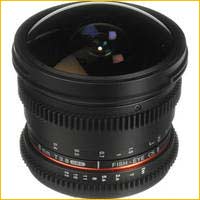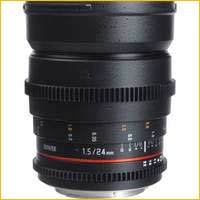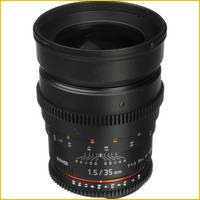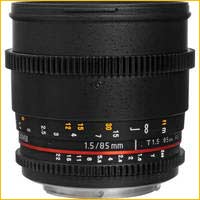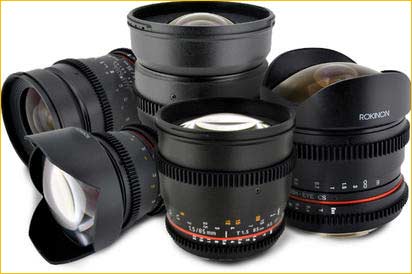
Whether you’re shooting with a DSLR, Compact System Camera (CSC) or large sensor interchangeable lens video camera, you probably have discovered two things about lenses. Those that are designed for still cameras are far from ideal when used for cine work, and lenses designed for cine work are very expensive.
Why Still Camera Lenses Aren’t Ideal for Cine
Optically, as long as a lens will mount, focus to infinity and cover the sensor, you’re fine. But it’s the mechanical side of things when there are issues. Here are a few…
– Aperture stops. Stills lenses have 1/3rd or 1/2 stop clicks. These create audio noise will filming and also cause visible jumps in brightness level. Cine lenses have no click stops and are continuous.
– Focusing. Autofocus is rarely used when shooting video or cinema. Manual focus is used and a lens with clearly marked distances and a smooth mechanical turn of between 90 and 120 degrees is desirable. Lenses that have “fly-by-wire” focusing are very difficult to work with.
– T Stops. Cine lenses are typically rated and marked in T (Transmission) Stops rather than F (Focal Ratio) stops. This means that the aperture shown and set is the real amount of light transmitted, not the theoretical value. The difference isn’t often large, but it is a distinguishing characteristic of the precision that cinematographers demand from their optics.

– Geared Rings. Cinema lenses have geared aperture, focus and zoom rings. These are so that so-called follow-focus devices may be used. For still photography a rubberized or plastic grip is fine. For cine use the gears on the follow-focus device have to mesh with gears on the lens. If the lens has none then adaptors must be used. These lenses have an industry standard 0.8 pitch, making them compatible with most external controls, including remote electronic aperture and focus.
– Marking Orientation. In the film world focus, aperture and other lens-based controls are typically done by an assistant that stands to the left side of the camera. Cine lenses have these markings on the side rather than the top of the lens. Even when working without an assistant this is helpful because with the camera high on a tripod side markings are easier to see and read than top markings, which might require standing on ones tippy-toes.
How Expensive are Cine Lenses?
Very! Other than the lenses being discussed here under the Samyang, Bower and Rokinon brands the least expensive cine lenses generally available are from Zeiss, in their CP.2 line which typically run between $4,000 and $6,000 apiece. Beyond that, the sky is the limit. For example, a set of eight Summilix-C lenses from Leica will cost $178,000. Yes, the price of a house in many places. Or, but more simply, about $22,000 a lens!
Affordability & Availability
So, now that you understand what a cine lens is, and why, and what they can cost, here’s an alternative. Quite an inexpensive alternative. Samyang, a budget lens maker from Korea has taken five of their still camera lenses, in Canon EOS, Nikon F, Sony E mount and MFT, and made them into cine versions. These lenses are sold around the world under different brand names – Bower, Rikonon and Samyang. These are all essentially identical, other than for some small cosmetic differences, packaging and warranty.
Note that these are so-called full-frame lenses, and are designed to cover the full135mm format.
The available cine lenses under theBowerlabel, with EOS mount, and with current B&H pricing are….
|
|
|
|
|
A little quick math shows that all five lenses combined come in at under $2,100. A truly remarkable price. The price wouldn’t be that remarkable, of course, if the lenses were crap, but they’re not. In fact if you browse the web, look at reports on Video and YouTube, and read various test of both the still camera and cine versions (optically the same) these lenses acquite themselves very well indeed.
Now if you own high-end cine lenses worth as much as a small car, don’t get your knickers in a twist. These lenses are not competition. But, for the film maker on a budget (someone using a Blackmagic rather than a RED Epic or Ari Alexa, for example), these lenses make perfect sense and are quite serviceable.
What You Don’t Get
Why so inexpensive? Well, you don’t get…
– no auto-diaphragm
– no autofocus
– no image stabilization
These are fully manual lenses, with no concessions to modernity other than their optical designs, coatings and glass. Exterior construction is high grade plastic, but the lenses have a heft that belies the fact they they appear to have decent quality helicals. This is confirmed by their smooth focusing. A pleasure to use compared to many fly-by-wire AF lenses.
Using Filters

Manfrotto Matte Box
One area where the quality of the Bowers and their sister lenses are sub-optimal is when it comes to the filter threads. On most manufacturers lenses these are metal, and can take continuous mounting and unmounting of filters. On the Bowers, and their cousins, the threads are plastic and you may find that constant threading and unthreading variable DN filters either jambs the threads or strips them.
The solution is to mount a good quality UV filter permanently on each lens (the 8mm and 14mm have large bulbous front elements and thus don’t have filter threads) and then attach your Fader to it. If the UV filter is of good quality there shouldn’t be any noticeable image degradation. Of course of you’re only using your lenses in the studio then you’ll likely be using a matte box so none of this is relevant.
Indeed, I would suggest that buy a matte box even (and especially for) outdoor use is a good idea. You just need to have one set of filters for all your lenses; they work with lenses like the Bower 8mm and 14mm that have large front elements and therefore can’t take screw-in filters, and they have adjustable French Flags (sun shields).
The Manfrotto Matte Box is a relatively inexpensive and versatile solution that takes 4X4″ filters. I’ll be examining these and other cine accessories when our Blackmagic 4K camera review goes live.
January, 2014
You May Also Enjoy...
Racing Photography
By: Lee CarneyIntroductionEvery weekend of the year, at hundreds of locations around North America, people gather to race motorized vehicles of every description. From stock
Where The #%*! Are My Pictures? Video Preview
This brief video is an excerpt from the HiRes version ofWhere The #%*!Are My Pictures? Return to theWhere The #%*! Are My Pictures?Announcement Page Movie
